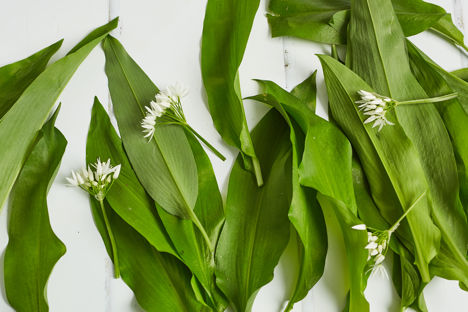Wild garlic is a truly idyllic culinary treat – a wild ingredient that, when in season, grows in abundance, nestled among bluebells, attracted by the moist soil and shady woodland environment. Wild garlic has enjoyed a culinary boom in recent times, taking its place alongside rhubarb and asparagus as a pillar of spring's bounty. It has a short season, usually first appearing in mid-March and lasting until early May.
What to look for when sourcing wild garlic
Wild garlic can be identified by its distinctive smell, long pointed leaves and white flowers, which bloom at the end of the season. Don’t pick wild garlic that has large amounts of white flowers, as this indicates older leaves which are likely to be slightly woody and bitter in flavour.
Although the pungent smell of garlic makes it easy to identify, always take care when foraging your own ingredients – there have been cases of people mistaking poisonous plants (such as Lily of the Valley) for wild garlic. That said, it is certainly one of the easiest things to forage for, as wild garlic smells particularly strong.
Wild garlic doesn’t have to be foraged. It’s a frequent staple of food markets at the peak of the season. As with all vegetables, choose wild garlic with bright, fresh leaves and avoid specimens that have wilted.
How to cook wild garlic
Always brush off any soil and wash wild garlic in cold water before eating.The leaves have a vibrant punch to them when eaten raw, so finely chopping them and using them in a similar way to herbs is a nice way to showcase the fresh flavour. Wild garlic dressings such as pesto or salsa verde are often whipped up for this reason.
Cooking the wild garlic leaves mellows out the flavour: simply blanch or wilt for 30–60 seconds as you would with spinach. It shrinks down a lot after cooking, so make sure you have plenty to hand. As a lot of wild garlic can sometimes be overpowering, mixing the leaves with spinach can be a good way to achieve a nice balanced flavour. If you aren’t eating straight after cooking, plunge into iced water to retain its vibrant green colour.
Another common use is to flavour condiments such as this Pea and wild garlic ketchup or Nud Dudhia’s Wild garlic mole recipe. Wild garlic mayonnaise can be made either by finely chopping and folding through shop-bought mayonnaise, or by making a wild garlic oil and then making the mayonnaise from scratch, as Pete Biggs does in his recipe.
Wild garlic flowers will give any dish a touch of cheffy presentation and their delicate floral garlic flavour is not to be missed. If you manage to catch the flowers in their buds just before they have bloomed, try pickling them. This is also a good way of reducing the amount of seeding the plant will do if your wild garlic patch is getting out of control!
Once the flowers are starting to go, you will be left with the three-cornered nobbly little seed pods. These can be picked, salted and pickled to create zingy little garlic capers. A lovely way to preserve wild garlic long after the season ends.
What wild garlic goes with
Being a quintessential spring ingredient means wild garlic is a natural accompaniment to other flavours of the season, such as spring lamb, new potatoes, morel mushrooms and asparagus.
Anna Hansen’s Wild garlic, new potato and black onion seed soup really puts the ingredient centre stage. Luke Holder pairs wild garlic with morels in a simple risotto which sings of spring, whilst Colin McGurran makes a wild garlic velouté to go with chicken and asparagus. Wild garlic also holds up to bolder seasonal flavour combinations – James Mackenzie’s Black pudding and langoustine crumble comes with a crisp wild garlic crust.
For a unique wild garlic-infused canapé, try Simon Hulstone’s Onion with wild garlic and snails, the mild wild garlic pairing beautifully with the sweet onion and punchy snails.
Wild garlic is a lovely way to brighten up any spinach dish which makes it nice and easy to get creative with. Think wild garlic pasta dough, malfatti dumplings, salmon en croute or spinach curries. The possibilities are endless, but if you’re after a little inspiration, check out some of our favourite recipes below.
Get in touch
Please sign in or register to send a comment to Great British Chefs.


